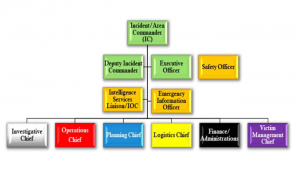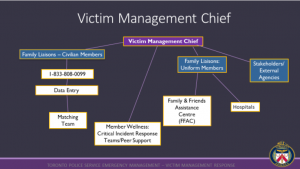Extreme events around the world have continued to increase at an alarming rate. Whether these incidents are mass shootings, stabbings, terrorist bombings, vehicle attacks, building collapses, or natural disasters, the one common thread is the significant impact they have on victims and the reverberating impacts on victims’ families.
For the Toronto Police Service and the City of Toronto, Ontario, the year 2018 proved that extreme events have no limitations on the harm that can be inflicted on a city and its residents.
On Monday, April 23, 2018, members of the Toronto Police Service, along with other first responders, responded to a vehicle attack directed at pedestrians along busy Yonge Street. These people were going about their regular days— out for a walk, working, going for lunch, enjoying the spring weather, or just enjoying life with friends
Within seven minutes, over 2.57 kilometers and 13 separate locations, 10 innocent lives were taken and 16 other people were injured. The effects of this attack went beyond anything anyone could have imagined. From a cab driver picking up a fare, to the woman sitting in the coffee shop window, to the first responder on scene, the impact was tremendous and far reaching, and continues today.
Just three months later, on July 22, 2018, in a Greek Town neighborhood, a lone male shooter opened fire on pedestrians and restaurant patrons. At the end of this sudden, seemingly unprovoked violent attack, the shooter had killed two young girls and injured dozens of other individuals. Many families and the community would be changed forever.
The impact of these two incidents was enormous in terms of the number of victims affected, their families and the many bystanders who happened to be at these locations, as well as first responders attending the scene. Their lives would be impacted forever.
Implementing a Victim-Centered Approach
These two events and an increased number of attacks happening globally further highlighted the importance of implementing the Toronto Police Services internal “Extreme Event Recommendations” of 2017. As part of the service’s commitment to a renewed approach and to move the organization forward, it was recognized that a critical change must include a commitment to how it is supporting victims.
Organizational Placement & New Roles within the Incident Management System
The importance of a preplanned and coordinated victim-centered response for victims, survivors, families, first responders, and all those impacted by these tragedies cannot be overstated. A response strategy developed in collaboration with key stakeholders will assist victims and their families by providing information and access to the support available to them that they may need in the short-, medium-, and long-term.
The important principles of an effective response to victims are ensuring a timely flow of information and prompt connection to services.
Shortly after the 2018 van attack, a working group of internal service members, both uniform and civilian members, was formed and the response and preplanning began to move forward. The Toronto Police Service recognized and immediately implemented the role of the victim management chief and identified it as a separate pillar of the Incident Management System (IMS) model, alongside existing pillars such as operations, planning, logistics, finance, and investigative sections.
Acknowledging the many lessons learned both internationally and across Canada, the Toronto Police Service understands and recognizes the following challenges that ensue as a result of an extreme event:
|
As part of the victim-centered approach, it is important for the Toronto Police Service to provide a continuous flow of information to the families, victims, and community. This in turn will reduce stress and anxiety and begin to build trust between victims and responders.
TPS Incident Management Structure during Major Incidents
Victim Management Pillar
| Figure 1: TPS Incident Management Structure |
 |
The victim management chief is the conduit of information for the victims, survivors, and family members. They are responsible for the collection, management, and dissemination of documentation as well as identifying all victims of an extreme event.
We know that at the time of an event, the families of missing or injured loved ones will, as expected in the circumstances, converge on the scene or at area hospitals. To further enhance the support of the victim management chief, family liaison officers will also be deployed to assist.
Incorporating Family Liaison Officers
In addition to embedding, the victim management chief in the IMS framework, the Toronto Police Service recognizes there needs to be a coordinated on-the-ground response to supporting victims.
Family liaison officers (FLOs) are key to ensuring an effective victim-centered response at the time of an extreme event.
FLOs assist and contribute to the overall investigation, but as members of the Incident Management Team response, they will work in collaboration with emergency services, health care professionals, victim support agencies, social service agencies, and governmental and nongovernmental organizations.
Deployment of FLOs to the scene, trauma hospitals, and the Family and Friends Assistance Centre (FFAC) will help in identifying victims and their families. The FLOs will also provide timely information in a respectful and compassionate manner and help to connect victims to external support agencies.
In May 2022, Toronto Police Service launched its first Family Liaison Officer Training and currently has 15 members available for activation.
| “The most valuable part of the FLO training was learning to look at things from a victim-centered approach and not as much as an investigator.”
—TPS FLO Member |
The Importance of Partnerships with Health Networks & Community Agencies
A coordinated victim response supported by the police and engaged victim support agencies at the time of an extreme event, may assist victims, survivors, and their families to cope, grieve, and begin the process of recovery.
Engaging community partners, support agencies, and health networks begins before an incident takes place. Preplanning and fostering relationships prior to an incident will help to ensure that the victims’ voices are heard and their needs are met.
| “The networks of victim advocacy groups, non-government organizations and law enforcement are the key to resilience….doing this together that is where we are better.”
— John Miller, Deputy Commissioner of Intelligence & Counterterrorism (Ret.),New York City Police Department, Voices of Resilience Symposium 2022 |
Final Piece of the Response: Critical Incident Response Teams (CIRT) for Internal Members
The importance of responders and the vital roles that they play during and after an extreme event cannot be overlooked.
| Figure 2: Organizational Chart |
 |
The Toronto Police Service knows firsthand from listening to members that attended the van attack that it was one the most difficult and emotionally challenging calls that they have experienced in their careers. This included both uniform members who attended the scene and civilian communication operators who answered the large number of calls from panic-stricken family members.
Agency members play vital roles during and immediately after an extreme event, and Toronto Police Service recognizes the trauma its members will face attending the scene, working with and supporting victims.
Ensuring that the victim management response includes the Critical Incident Response Teams (CIRT) in the initial activation of the victim management chief pillar is the final piece of the solution. If law enforcement is not supporting its own members both physically and psychologically, how can they be expected to support victims of a mass casualty?
Putting Victims First
By putting victims first and implementing a victim-centered approach, the Toronto Police Service is focusing on the needs of the victim in a respectful and compassionate manner.
Engaging with victims and making sure that their voices are heard will minimize re-traumatization while ensuring that their safety and well-being take priority at the time of an extreme event. d
Please cite as
Danielle Bottineau, “Why Is a Victim Management Response Important? The Toronto Police Service’s Approach to Victims of an Extreme Event,” Police Chief Online, November 16, 2022.



